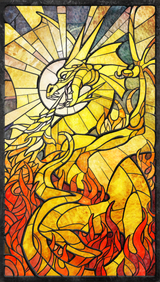Search Results
7/20/2025, 2:21:17 AM
>>40759093
>Plato’s Seventh Letter, as we have seen, comes to the same conclusion. The flash of illumination that carries the highest explanation does not belong to the conscious verbal apparatus of the mind. All discoverers concur.
>Proclus (412-485 A.D.), whose valuable works lie mostly untranslated, understood this point, writing in the course of Chapter 29, Book II of his Platonic Theology:
>"Only the uniting with a higher consciousness bestows the successful completion of processes of the spirit that go beyond reasoning, and the accompanying power of symbols which are verbally inexpressible. Such higher processes are not worked by discursive thought and we cannot bring them into activity by mere intellectual processes. The divine characters or symbols [which could be mandalas or yantras, pictures, models, symbols, or numbers] do much more in this regard, in that we are not then (consciously) thinking. Such means unite our normal consciousness with one more divine; for the hidden divine powers on which such symbols draw recognize therein their own representations (without the necessity that we do so by any conscious thought or effort)."
>Thus in Lao-tse and Plato, the entire point was that ineffability due to the limitations of words was not an absolute basis, but could be transcended by non-conscious powers and processes of mind.
>Plato’s Seventh Letter, as we have seen, comes to the same conclusion. The flash of illumination that carries the highest explanation does not belong to the conscious verbal apparatus of the mind. All discoverers concur.
>Proclus (412-485 A.D.), whose valuable works lie mostly untranslated, understood this point, writing in the course of Chapter 29, Book II of his Platonic Theology:
>"Only the uniting with a higher consciousness bestows the successful completion of processes of the spirit that go beyond reasoning, and the accompanying power of symbols which are verbally inexpressible. Such higher processes are not worked by discursive thought and we cannot bring them into activity by mere intellectual processes. The divine characters or symbols [which could be mandalas or yantras, pictures, models, symbols, or numbers] do much more in this regard, in that we are not then (consciously) thinking. Such means unite our normal consciousness with one more divine; for the hidden divine powers on which such symbols draw recognize therein their own representations (without the necessity that we do so by any conscious thought or effort)."
>Thus in Lao-tse and Plato, the entire point was that ineffability due to the limitations of words was not an absolute basis, but could be transcended by non-conscious powers and processes of mind.
7/19/2025, 8:26:28 PM
!!P38zFLDUYUh/x/40570787#40575407
6/21/2025, 8:14:13 PM
>The Amulet of Kings
>by Wenengrus Monhona
>Chronicles the creation of the Amulet of Kings
>In the first years of the First Era, a powerful race of Elves called the Ayleids, or the Heartland High Elves, ruled central Tamriel with an iron hand. The high and haughty Ayleids relied on their patrons, the treacherous Daedra Lords, to provide armies of Daedra and dead spirits; with these fearless magical armies, the Ayleids preyed without mercy upon the young races of men, slaughtering or enslaving them at their whim.
>On behalf of the suffering human races, St. Alessia, the first in the line of Cyrodiils, sought the aid of Akatosh, the Dragon God of Time, and ruler of the noble Aedra. Akatosh, looking with pity upon the plight of men, drew precious blood from his own heart, and blessed St. Alessia with this blood of Dragons, and made a Covenant: so long as Alessia's generations were true to the dragon blood, Akatosh would endeavor to seal tight the Gates of Oblivion and deny the armies of Daedra and undead to their enemies, the Daedra-loving Ayleids.
>by Wenengrus Monhona
>Chronicles the creation of the Amulet of Kings
>In the first years of the First Era, a powerful race of Elves called the Ayleids, or the Heartland High Elves, ruled central Tamriel with an iron hand. The high and haughty Ayleids relied on their patrons, the treacherous Daedra Lords, to provide armies of Daedra and dead spirits; with these fearless magical armies, the Ayleids preyed without mercy upon the young races of men, slaughtering or enslaving them at their whim.
>On behalf of the suffering human races, St. Alessia, the first in the line of Cyrodiils, sought the aid of Akatosh, the Dragon God of Time, and ruler of the noble Aedra. Akatosh, looking with pity upon the plight of men, drew precious blood from his own heart, and blessed St. Alessia with this blood of Dragons, and made a Covenant: so long as Alessia's generations were true to the dragon blood, Akatosh would endeavor to seal tight the Gates of Oblivion and deny the armies of Daedra and undead to their enemies, the Daedra-loving Ayleids.
Page 1
